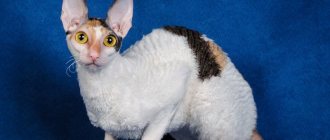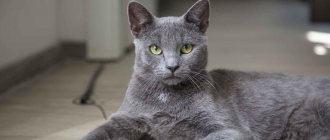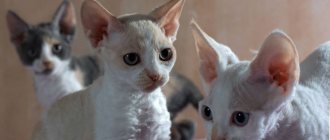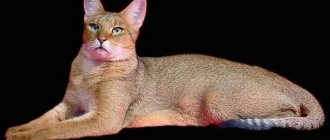Rules for a healthy diet for the Cornish Rex
It is worth considering that adult animals eat a lot. To correctly calculate portions, you must follow these tips:
- Observe the norms of plant polysaccharides, as a kind of cell building material.
- Choose the right fiber for optimal gastrointestinal function.
- Avoid excess carbohydrates in food, so as not to exceed the critical weight for large pets.
- Ensure the optimal content of “good” fats in the food, because lipids are the source of energy for the cat’s body. With a lack of Omega-3 and Omega-6 fatty acids, problems with the coat may begin and various diseases will appear.
- Organize feeding with the correct content of animal proteins. The amount of arginine is especially important; it is precisely with its insufficient composition that disturbances in the functioning of the cardiovascular system are possible in animals of this breed.
- No less important for the healthy functioning of the heart is taurine, which the predator’s body is not able to reproduce on its own. In addition, with a lack of this element, retinal degeneration can occur.
- Do not forget about the importance of the presence of vitamin complexes and fat- and water-soluble additional minerals in the diet.
When organizing the nutrition of this large pet, it is important not to forget about the predatory natural way of life of this animal and provide the diet with complete meat products or dry industrial mixtures that are as close as possible in the composition of elements to the diet of wild ancestors.
It is especially worth making sure that you feed your Cornish Rex regularly at certain times and keep your pet's water and solid food bowls clean.
Character, behavioral characteristics
The character of the Cornish Rex is soft and docile. These are sophisticated intellectuals, distinguished by their emotionality. A vigorously wagging tail is evidence of increased receptivity.
Representatives of the breed have natural cheerfulness, curiosity, and are very active. They like to be on the move all the time, climbing, jumping. Even adults retain playfulness. Nevertheless, the behavior can be considered correct: the Cornish are delicate, patient, unforgiving, and they will not do any mischief. Thanks to their increased sensitivity to a person’s mood, they always know how to behave in a given situation.
The paws have membranes between the toes. Cats love water and can swim in bathtubs and natural bodies of water.
Learning ability
Cornishes are very smart, quick-witted and obedient. If the animal is treated correctly, it can be taught to follow simple commands and walk on a harness. Representatives of the breed quickly learn funny games and can fetch small toys on command.
Attitude towards the owner, children, strangers
They are somewhat similar in behavior to dogs: the family chooses one owner, to whom they feel boundless devotion. However, they also show love and affection towards other members of the household, as they are very friendly and sociable. They love attention to their person; if you talk to a cat, it will look into its eyes and, like a dog, wag its tail. They cannot tolerate being ignored, neglected, or rude.
They do not like excessive familiarity from strangers. They are distrustful of strangers, but can be curious. Children are treated kindly, representatives of the breed are non-aggressive. Rex can be an ideal playmate if you explain to your child the rules of handling a cat.
Attitude towards other pets
They get along well with their relatives and other pets, including dogs, but they love to be in the company of people. The owner should try to give the same amount of attention to all animals. In relation to birds and rodents, they show aggression caused by hunting instincts.
The best dry food for the Cornish Rex
According to veterinary standards, high-quality finished food must contain at least 26% protein and 9% fat. For lactating cats – 30% protein and 9% fat. The first thing you need to pay attention to when choosing industrially produced food is that protein (meat) should be the first ingredient on the label. If soy or grains come first, this food is not suitable for the breed.
Second, and no less important, avoid foods that contain corn or wheat gluten. Choose grain-free products - they do not lead to obesity. Grain is not an essential part of a cat's diet—in the wild, cats do not eat grain!
Small bowls and saucers are not suitable for Cornish Rex kittens. You should choose water bowls with a diameter of at least 30 cm and 10 cm in depth. There should be at least half of the container with water. You need to change the water at least once a day. Kittens love to play with water: they make waves, row, splash and dig.
Dog sippy cups are the best option for this breed. Metal or ceramic bowls on a stand are suitable for dry food.
You need to be very careful when choosing food for your little Cornish Rex. The baby’s development, appearance and ability to reproduce will depend on its correct selection.
Cats of this breed feed their kittens milk for up to 2-2.5 months. But the first complementary foods can be given when the kitten is 1 month old. Additional nutrition is introduced based on the baby’s condition and development. The Cornish Rex needs milk until it is 2 months old.
If a kitten is separated from its mother, it is given adapted milk from pet stores or bought goat milk. Cow's milk does not contain enough proteins and fats, which are so necessary for the growing body of a large cat. Up to 4 months, you need to feed 5-6 times a day in small portions.
Kitten feeding frequency:
- 3-4 months – 5-6 times;
- 4-6 months – 4 meals a day;
- from 6 months – three meals a day;
- 10-12 months – morning and evening.
Don't forget that Cornish Rex cats reach sexual maturity later than other breeds. Therefore, the Cornish Rex's diet up to the age of 9 months should consist of special food for kittens.
The main advantage of ready-made industrial feeds is their balance. This does not apply to cheap food from supermarkets. Feeding Cornish Rex kittens Whiskas and Kitekat is unacceptable! You can switch to dry food at the age of 3 months.
Make sure the bowl is clean and there is no food left in it. Anything that the kittens haven’t eaten must be removed after feeding.
Health, tendency to disease
Corinche Rex cats are distinguished by good health; a possible reason for good immunity is a slightly elevated temperature (38.5-39 ° C). No genetic problems (breed diseases) were found. The most common types found in rexes are:
- skin diseases (dermatitis);
- colds of the respiratory tract;
- gastrointestinal disorders;
- cystitis (inflammation of the bladder).
Animals tend to overeat, which can cause obesity. Cornish Rexes are very sensitive to anesthesia drugs, therefore, unlike cats of other breeds, they take longer to recover from anesthesia. An overdose of sedatives used before surgery can cause complications: deafness, neurological disorders, damage to brain cells, and death.
It is recommended to have a first aid kit for your cat. Need to buy:
- cotton wool,
- cotton buds,
- elastic bandage,
- gauze,
- patch,
- brilliant green,
- iodine,
- hydrogen peroxide,
- Activated carbon,
- Vaseline oil (Vaseline),
- scissors with blunt tips,
- tweezers,
- eye dropper,
- rectal thermometer,
- syringes, incl. insulin,
- ammonia,
- boric acid powder,
- streptocide powder.
Vaccination
They begin when the kitten is 8 weeks old. First you need to rid the animal of fleas and ticks, then deworm it. The remedy for parasites is given 10-12 days in advance. before vaccination. First, they are vaccinated against panleukopenia, calicivirus and rhinotracheitis. Revaccination is necessary after 2-4 weeks, then 1 time per year.
Starting from the age of 12 weeks, they are given a rabies vaccination (once), revaccination – annually.
After 2-3 weeks. The kitten is vaccinated against fungal diseases. 2 injections are required, with an interval of 10-14 days, revaccination - every year.
Quarantine after vaccinations should last 10 days, during which it is important to protect the baby from:
- overheating;
- hypothermia;
- strong physical activity;
- long transportation;
- contacts with other pets;
- suspected sources of infection (for example, street shoes).
Feeding the Cornish Rex with ready-made formulas
Feeding animals of this breed with ready-made industrial mixtures is the easiest way to organize proper nutrition for your pet. Sheba classic kidney food for cats.
These are wet canned food, spiders and dry food, which can be stored longer and are always available to the pet in the open if there is a bowl of water.
The Cornish Rex should be fed a super premium or holistic diet. In general, there are good premium foods, but in this case you need to study the composition very carefully.
You should not give your Cornish Rex wet food from cheap brands such as Whiskas, Kitekat, Friskas. Pets usually eat them with pleasure and quickly get used to the tastes, but it should be remembered that they do not contain high-quality meat and a lot of mineral salts. We also do not recommend feeding cats Royal Canin diets for this breed. Indeed, now everyone is buying them. But let's look at the composition. For example, Maine Coon Adult in sauce for cats over 15 months old.
- It is not specified what kind of meat is contained, how much of it, the phrase “meat by-products” - also no specifics, what quality they are, they may not be very good.
- In second place are cereals, again, without further clarification, they are poorly digested by cats and serve as a cheap filler. It is better that they are not in the stern at all, or at least not higher than fifth place.
- The composition contains protein extracts of plant origin, plant by-products - again, nothing good.
We can conclude that this is an economy class, although the manufacturer classifies it as premium. Of course, there are no dyes or preservatives, but Whiskas doesn’t have them either.
So what kind of wet food can you give? We recommend Animonda, Leonardo, Applaws, Bozita. The latter has wet food for large breeds, however, it contains unwanted cellulose.
If we talk about dry mixtures, today a certain rating of these feeds has been formed, popular both among experienced breeders and private owners:
- Leading the list is Wellness, a fairly new product on the market from American manufacturers. It contains natural salmon and tuna, meat and fish flour, a small content of plant components, such as peas, and no grain. Wellness® Indoor Health for Adult Cat is suitable for young adult cats, but there are also products for pregnant and lactating cats, and kittens with a high content of animal protein. The disadvantage of this holistic product is that it can not yet be purchased in Russia even in all online stores and at a very high price.
- Bosch Sanabelle Grande takes second place in the ranking. The German manufacturer classifies this product as a super premium class product, but it is made from products suitable for human nutrition, which meets the criteria of canvas. The composition is based on liver and poultry meat, rice, millet, and sorghum. Based on the content of components, it is optimal for the prevention of urolithiasis; the granules are large and pets really like it.
We also recommend Akana and Orijen food. Although they have a small selection of flavors, the quality is very high. Read the article review of food for cats and kittens.
Good food:
- Hill's Nature's Best™ With Real Chicken Adult Cat is made in the Netherlands. The mixture contains high-quality products - poultry meat, plant components are represented by oats, rice, potatoes, and corn. The protein content is high. Cornish Rexes love this mixture very much.
- Eukanuba Mature Care Formula for Cats contains many meat ingredients, but also contains grains. Cornish Rex eat this dry mixture with pleasure, although some pets have allergic reactions.
- ProNature 30 Adult for Cats - until recently, breeders considered this Canadian food one of the best products in terms of price-quality ratio. In addition, the pets always ate it with pleasure. The only thing is that since production opened in Russia at the beginning of 2021, the level of Pronature has decreased significantly and many breeders have begun to abandon this feed. Contains chicken, corn, peas.
Natural diet for Cornish Rex
Most owners of animals of this large breed prefer natural products in feeding their pets. It should be remembered that at least half of the diet should consist of meat ingredients. The following components must be present in the diet:
- Meat and offal (stomachs, heart, liver) from poultry, mainly chicken.
- Beef in the form of meat and offal, preference should be given to low-fat varieties.
- Fermented milk products are low-fat cottage cheese, natural yogurt, kefir, fermented baked milk.
- Cheeses in the form of hard varieties.
- Cereals are porridges prepared according to special recipes from buckwheat and multigrain mixtures.
- Fresh and boiled vegetables - carrots, cabbage, zucchini, pumpkin, cucumber.
- Some types of sprouted grains and specially grown grass.
- Brewer's yeast and meat and bone meal, fish meal.
- Vitamin supplements, special pastes for removing hairballs from the gastrointestinal tract.
As an example of porridge, in which the majority of protein components are occupied, we can recommend the following composition:
- meat and chicken by-products – 80%;
- fermented milk products – kefir or cottage cheese – 5%;
- vegetable and green components (zucchini, pumpkin, cucumber, spinach, celery, carrots) – 5%;
- oatmeal or buckwheat – 10%.
Here is another composition of the diet, which owners usually prepare for several weeks, divide into portions and freeze (in grams):
- beef kidneys – 500;
- beef liver – 500;
- heart (beef or veal) – 100;
- light beef – 100;
- necks and heads of chicken broilers – 100;
- beef or veal meat – 100;
- chicken stomachs or hearts – 1000;
- turkey fillet – 1000;
- pumpkin and zucchini – 1000;
- carrots – 500;
- kelp – 1000;
- wheat bran – 500.
By-products and meat, lightly boiled vegetables are passed through a meat grinder, the bran is poured with boiling water and infused. The finished mixture is packaged and deep frozen for three to four days.
Before eating, the bag is defrosted and placed in bowls; the porridge can be topped with natural unsweetened yoghurt or fermented baked milk, and pieces of hard cheese can also be added.
Supporters of natural nutrition need to remember that the Cornish Rex is a huge and very energetic cat. Cats of this breed behave like young kittens for a long time. In order for them to grow healthy and energetic, they need a high-calorie diet that provides the body with the necessary energy.
Meat should form the basis of the diet. Choose only high-quality and fresh lean meat: rabbit, beef, poultry and veal. You should give raw meat that has been previously deep-frozen. It is best to prepare portioned pieces in advance by cutting them and freeing them from tendons, films and bones. Do not give cats cold food (directly from the freezer); keep it warm until it reaches room temperature.
Fish is given no more than 1-2 times a week. Sea fish can be given raw, but river fish must be boiled. Eating fish more frequently can cause the Cornish Rex to develop urolithiasis.
What other products can be included in the Cornish Rex menu:
- by-products: liver, kidneys, lung;
- boiled egg;
- cereals in limited quantities;
- vegetables: carrots, cucumbers, cauliflower;
- green salad;
- cheese as a treat.
Health
If you do not intend to breed Cornish Rex cats, it is better to have them spayed or neutered. Animals can be spayed and castrated after puberty, within 1.5 years of a cat's life (this is due to the correct formation of the genitourinary system). The operation takes place in a veterinary clinic and usually lasts 15-20 minutes under local or general anesthesia. As a rule, after anesthesia it takes 24 hours for the animal to recover. Try to pay more attention to your beloved pet on this day. If your cat’s anesthesia does not go away within 24 hours, be sure to contact the veterinarian where the operation took place.
A female who has not given birth to kittens and has not undergone sterilization will develop health problems over time, and an uncastrated cat is capable of marking corners in the apartment throughout her cat’s life, excreting specific smelling substances in her urine.
The Cornish Rex breed is characterized by good health, but you should still be aware that some diseases do occur.
- Alopecia. When a kitten is born, a delicate fluff appears on it, which disappears after two weeks and the animal becomes bald. It happens that the disease affects not only the fur, but even the claws and whiskers.
- Retinal atrophy is a genetic disease. Unfortunately, the Cornish are among the leaders in this disease. The disease can only be diagnosed in a specialized clinic.
- Impaired metabolism. Similar health problems in the Cornish Rex can occur due to improper metabolism. Only a veterinarian can determine whether the metabolism is impaired.
- Hypokalemia is a complex disease consisting of a lack of potassium. The disease is recognized as hereditary and can manifest itself in a baby if the male and female suffered from this disease.
- “Greasy tail” - occurs due to the strong secretion of fat from the sebaceous glands that are located under the tail. A waxy mass with an unpleasant odor accumulates on the fur near the tail, inflammatory processes occur, and the skin turns red and becomes wet. In the case of a chronic form of the disease, the tail becomes bald.
Vitamins and minerals for the Cornish Rex
These components play a very important role in the nutrition of the Cornish Rex. Preference should be given to complex drugs, having previously discussed their composition and brand with a veterinarian.
Some pets may benefit from mono-supplements that contain only certain elements, such as calcium, phosphorus, iron, vitamins B or E.
Typically, the veterinarian will first evaluate the animal's urine and blood tests in order to select the appropriate composition of vitamin and mineral supplements.
These complexes are necessary for natural nutrition of the Cornish Rex; in ready-made industrial mixtures, as a rule, all vitamins, micro- and macro-additives are present in the required quantity and ratio.
Intelligence.
The Cornish Rex's high intelligence has a positive effect on the amazing variability of behavioral reactions. These cats are very perceptive, easily understand a person and calmly fulfill the owner’s demands if they coincide with their own desires.
Cornish Rex dogs are easy to train and, with the right amount of training, can easily master some simple, typically canine tricks. For example, you can train your cat to find and retrieve a ball you throw. All Cornish Rex cats, without exception, will appreciate such training for the body and mind.
This breed is distinguished by high sensitivity and emotionality to everything that happens around them. Professional energy therapists attribute healing qualities to Royal Cornish cats, along with Siamese cats and Sphynx cats. It is recognized that being near them has a beneficial effect on the nervous system of owners and can cure depression.
What to feed a Cornish Rex kitten at 2, 3, 4 months and later
The Cornish Rex differs from other breeds in its unusually long period of maturation and growth. Only the formation of the musculoskeletal system is completed by the 15th month of life, and the cat sometimes reaches full growth only by four years.
When raising kittens, it should be taken into account that they gain weight quickly; by the age of three months, the baby weighs at least 2 kg, which is at least twice as much as the cub of an ordinary domestic cat. Therefore, the kitten must receive sufficient amounts of calcium, phosphorus, and vitamin D for the proper formation of the skeleton, musculoskeletal system, and muscles.
In addition, massive jaws grow very quickly, which is another distinctive feature of the breed. The granules of dry food for kittens should have a predominantly cubic shape so that the load is uniform. In addition, in this case, babies are forced to carefully gnaw and chew food, which also promotes oral hygiene; plaque is well cleaned and tartar does not form.
The first dry complementary food is usually given to kittens once a month and its composition remains the same for up to six months, only the number and frequency of feedings changes.
Month-old kittens are also given natural milk, with preference given to goat milk. Or they are fed with ready-made dry milk formulas. At first, they are fed six times a day, supplementing the diet with cereals, meat and vegetables.
At 3-4 months, they are switched to eating four times a day; crushed poultry giblets, vegetable ingredients, and fermented milk products are introduced into the diet.
Six months to a year is the most active growth period for a Cornish Rex kitten. If the baby is not gaining enough weight, then the diet is reviewed, changing the ready-made formula to a more nutritious one or supplementing the menu with seafood.
A new component is always introduced gradually, with careful attention to ensure that no allergic reactions or changes in stool occur.
Normally, the growth of a Cornish Rex kitten per month during this period is 300-400 g.
History of the origin of the breed
The first birth of Cornish Rex kittens dates back to 1950. As is the case with many other breeds, pets with wavy hair appeared completely by accident, and not as a result of breeding. The curly coat was nothing more than the result of a gene mutation. After this, the phenomenon began to be actively studied, and in 1967, the Cornish Rex was added to the list of breeds.
About 15 years passed before the breed was finally recognized by all felinological organizations. To preserve the gene responsible for the wavy coat, the Cornish Rex was crossed with a domestic or Siamese cat. It is prohibited to cross representatives of the breed with each other - because of this, the recessive gene may be suppressed.
Few people know that the world could have seen a new breed much earlier than in the middle of the 20th century. A few years earlier, its first representative was seen in Berlin near one of the hospitals. Passers-by did not pay due attention to either the kitten’s charm or its short curly fur: the post-war years forced the Germans to think about more important things than a homeless, albeit unusual, animal. For this reason, the Cornish Rex breed officially began its existence in 1950, and the reason for this was simple accident.
On a July morning, Nina Ennismore, the owner of a small farm near the village of Bodmin Moor in Cornwall, received a surprise in the form of an unusual kitten, which was radically different from its brothers from the litter. While the four-legged inhabitants of English farms had a dense coat, a round head and an impressive bone structure, the newborn baby became the owner of curly hair, a flexible body and a wedge-shaped head.
Dr. Jude confirmed the veterinarian’s words: Kalibunker is the first representative of a new breed, which is fundamentally different from those already registered. Responsibility for its development fell on the shoulders of Nina Ennismore, who came up with the name - Cornish Rex. The first part of the word indicated the homeland of the breed, while the second did not speak of aristocratic origin, but served as some kind of reference to the woman’s previous activities. So, she bred Astrex rabbits, which, like Kalibunker, had curly fur.
First of all, Jude and Stirling-Webb suggested testing the kitten's mutation for stability. When the animal reached sexual maturity, Miss Ennismore crossed him with his mother Serena, who was an ordinary mongrel cat. As a result of mating, three kittens were born, two of which had the same remarkable appearance as Kalibunker. Unfortunately, only one of them survived, later named Poldu.
Six years after breeding began, Nina Ennismore encountered financial problems that made breeding cats difficult. First of all, this affected Serena and Kalibunker, who suffered a cruel fate. Previously beloved by women, the cats were euthanized at the request of their owner.
A similar fate awaited Cornish Poldoux, if not for the timely intervention of Stirling-Webb, who bought the cat and continued working on the breed on his own. However, this decision also had unpleasant, almost fatal consequences.
When the tissue was collected, Poldu was neutered due to negligence. The only representative of the breed surviving by 1960 was Sham Payne Charlie, who later began to be crossed with other cats
Cornish Rex cats were officially registered in Great Britain seven years later.
She arrived in America almost pregnant and soon gave birth to two Cornish Rex blue and white cats. It is noteworthy that the father of the kittens was the long-suffering Englishman Poldu even before the ill-fated meeting with the veterinarian’s scalpel. With these charming babies, the spread of the breed throughout the United States began.
Once again, the Cornish Rex is in danger of extinction. In an attempt to prevent this, Diamond Lee crossed breeds with each other. Siamese, Burmese and American shorthair cats became worthy genetic material for further breeding of Cornish cats. This experiment entailed minor changes in the appearance of the rex, but at the same time gave them a huge variety of colors and colors. However, at present, crossing this breed with others is strictly prohibited.
In 1983, the largest felinological organizations officially registered the Cornish Rex. Now this breed is becoming increasingly popular due to its sophisticated aristocratic image and inexhaustible love for its owners.
Nutrition of an adult Cornish Rex
In nature, raccoon cats feed on small mammals, so even when kept at home, portions of a healthy, adult pet should be small and meals should be fractional.
At one time, an adult animal should eat 6-7 g of food in a few minutes. Feeding takes about half an hour a day.
Scientists have found that the Cornish Rex, like the Siamese, eats somewhat faster than other cat breeds; for example, the Persian eats no more than 2 g per minute.
The structural features of the jaws require a special form of dry food granules; the pet should always gnaw and chew them thoroughly, never swallowing them whole. The diet must contain Omega-3 and Omega-6 fatty acids and taurine.
Pets are considered adults from the age of 15 months, at the same time they are transferred to food of a different age category.
The cubic shape of the granules will greatly help to cope with cleaning the oral cavity, but to prevent stomatitis and gingivitis, periodontal disease, it is still better to brush your teeth once a day, first with a soft cloth (kittens), and then with a special brush and paste.
Dry food is selected based on the pet’s preferences; you can occasionally give high-quality wet spiders as a treat, correspondingly reducing the amount of the main product.
Research by scientists has shown that Cornish Rex dogs are prone to hip dysplasia due to their heavy weight (about 23% of animals suffer), so the owner must pay special attention to their diet. Only a high-quality diet containing polyunsaturated fatty acids will help the proper development and maintenance of the normal musculoskeletal system.
Heart pathologies are also common among representatives of this breed. The most common cases of hypertrophic cardiomyopathy occur when the left ventricle of the organ is overstretched. This is due to a natural mutation in the protein gene that is responsible for binding cardiac myosin. To exclude pathology, the kitten should also undergo appropriate tests and be examined completely. Sometimes the disease manifests itself only in adulthood, so an ultrasound of the heart should be performed once a year.
Foods that contain taurine, EPA and DHA in the right proportions can support normal heart function in an adult Cornish Rex.
Special food should be selected for pregnant and lactating cats. Experienced breeders from an early stage switch expectant mothers to kitten food with a high content of animal proteins.
Aging pets from about the tenth year of life also need special nutrition to prevent the development of chronic diseases. If we talk about dry industrial mixtures, Eukanuba has specialized lines for this age group: “Mature & Senior”, BioMill: “Cat Senior”, Perfect Fit: Senior, Bosch Sanabelle: Senior, Pro Plan: Vital Age 7+ Dry Chicken & Rice.
Choosing a kitten
When choosing a Cornish kitten, you should initially decide for what purpose you need the animal: for the soul or for breeding and exhibitions. In the latter case, it is very important to complete the following points:
Meet the kitten's mother, or better yet, both parents. It is by their appearance and behavior that one can understand what kind of character and appearance an adult pet will have. If the parents have defects in appearance or character traits atypical for the breed, they will almost certainly be inherited by the baby. Such a kitten is not suitable for breeding and participation in exhibitions. It is also very important to inquire about the health of the parents. Check the availability of documents (this includes a certificate from a veterinary clinic and vaccinations and a metric). Assess the animal's health status. Study the living conditions: how clean, tidy, warm and spacious the room is. What other pets did the kitten live with, and was he toilet trained? You also need to ask about their diet. Try to make contact with the animal. If a pet is needed for the soul, pedigree may not play a significant role. However, it is advisable to buy a kitten in special clubs, nurseries, from breeders or friends. If the animal was picked up on the street or was purchased blindly (via the Internet), you need to visit a veterinarian and make sure that everything is fine with the pet.
Allowed and prohibited foods for the Cornish Rex
In the case of natural feeding of the Cornish Rex, you should listen to the advice of experienced breeders and be sure to include in the feeding diet:
- Chicken heads, tails, necks, wings, paws. These products are usually ground up and given to pets after deep freezing as part of porridge; they contain many substances necessary for the healthy existence of a predator.
- Although pork is considered an unfavorable food for cats, occasionally the Cornish Rex should be given pork heart, as it contains a record amount of taurine. It is passed through a meat grinder, frozen and added to portioned porridge.
- Fermented milk products, especially cheeses, kefir and cottage cheese, must be included in the Cornish Rex’s diet. You just have to watch the fat content.
- It is advisable to sometimes give marine varieties of fish: pink salmon, salmon, cod are suitable.
There is also a fairly extensive list of foods that are strictly prohibited from feeding the Cornish Rex:
- Viscous cereals with a lot of milk have a bad effect on the gastrointestinal tract and often cause diarrhea.
- Baked goods, pastries, pies, cookies, preserves and jams, other sweets and chocolate are prohibited.
- Boiled poultry bones should be excluded from the diet; it is the fragments of tubular elements that can injure the gastrointestinal tract.
- Pork should be completely removed from the diet; it is a heavy meat product that is dangerous for cats in many ways (except for the heart).
- Potatoes, beans, beans, peas, and tomatoes are not allowed as vegetables. They cause increased gas formation and diarrhea.
- River fish should not be given, as there is a high risk of infection with parasites. In addition, it contains many small and sharp seeds.
- Whole cow's milk is not recommended in the diet of adult animals.
- It is also worth excluding sausages, sausages, smoked, pickled, canned, salted, hot and spicy foods.
In strictly limited quantities, they give the yolk of raw chicken eggs (the white is prohibited), olive oil (and other vegetable oils), poultry liver, and seafood.
The most complete types of meat for the Cornish Rex are turkey, rabbit, beef, and lamb. Chicken is healthy, but feeding this bird alone is not enough in terms of animal protein content.











